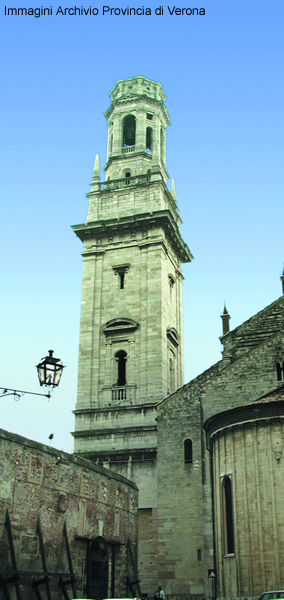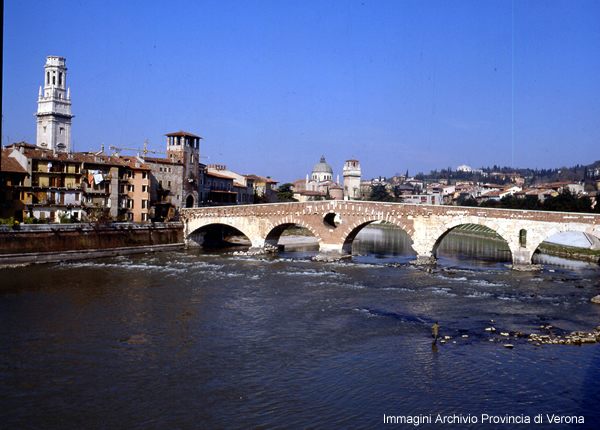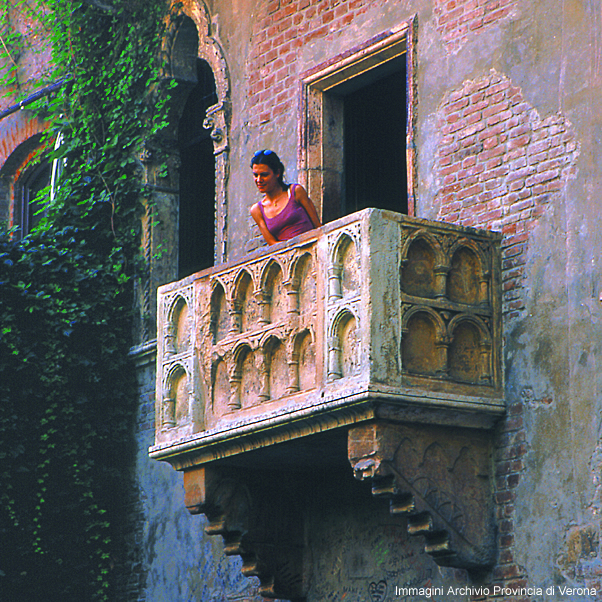|
Verona has a ancient historic centre, very extensive and well conserved. Roman municipality of the 49 b.C., reserves importan tracks of that prosperous period. The roman amphitheatre called the Arena, one of the most famous outdoor theatre in the world, the Roman Theatre, the Gavi Arch and the monumental gates (Porta Borsari and the Porta dei Leoni) are grand works designed to last millennia.
Noteworthy architectural works remain from the Scaliger's Seignory and from the Austrian domination during the Risorgimento, but there are also, palaces and squares of every epoch and style in warm soft colors.
The churches of the town are numberless and of great historical and artistic value. Some of the most important are: the Basilica of San Zeno, a perfect example of Romanesque architecture, is dedicated at the Saint Patron of the town and the panels of bronze that adorned the wooden doors, are a work of the local sculpture. The churches of San Fermo, Santi Apostoli and San Lorenzo date back to the same period while the church of Sant'Anastasia was built during the the Scaligers' Seignory and is the home of fresco masterpeces by Pisanello and Altichiero. The church of San Giorgio is attributed to Sanmicheli, an architect who worked at several of the most important palaces and fortresses of the city.
A small marble balcony records the most famous verses of Shakespeare tragedy, in which Romeo declares his love fo Juliet, Shakespeare's immortal heroine, as she stands on it. The building, which probably dates back to the XIII century, has a brick facade and large tribolate windows; following the tradition it is the house where the beautiful Juliet lived. Her tomb is located instead in an old monastery and the place is imbued with an intensely romantic atmosphere.
The other eternal symbol of Verona is the Arena: the magnificence of the roman ruins, the perfection of the staging and the musical shows give to the performances of the Arena that inimitable tone which since 1913 has been attracting big crowds of spectators to one of the most prestigious opera seasons. Every year the rich program includes works, concerts and ballets. Verona offers also many folklore events between which the "Bacanal del Gnoco", the veronese carnival, arrived at the 475^ edition.
The territory of the Scaligera province is embraced from north-west at south-east by the Adige river: about ten of bridges connects the two parts of the town, but in the roman period Verona had only two bridges: the Pons Postumius (doing not more exist), and the Pons Marmoreus. This last, known like Ponte Pietra, destroyed during the Second World War, was rebuilt using the original parts; suggestive also the Ponte Scaligero, in the neighbourhood of Castelvecchio, also it, like the previous, exclusively to pedestrian use, was built and fortified during the Seignory of Della Scala for civic and military purposes.
The territory around of Verona is rich of story: there is not in fact one veronese town which cannot boast at least one stately residence or a medieval castle or the memory of some important past events. Soave, Villafranca, Cologna Venetam Valeggio sul Mincio, are some of the most significant examples of this heritage,
Around at those and other centres are extended the fertile veronese plain, in the South part called also "Basso Veronese", rich of products of the agriculture, of handicrafting tradition and important firms. Its delicate and poetic landscape should not be overlooked, especially during autumn.
The chain of the Mount Baldo erises at north-ovest in comparison with the town and, in the last centuries was called, from botanists and naturalists "Hortus Europae" for the extraordinary variety of flora species, more of which endemic. Appeared on the lake of Garda like a incomparably beautiful balcony, the mountain can be easily reached also with the new cableway that covers the route between Malcesine and the Mount Baldo with a inequality of 1650 metres, in only 10 minuts.
The north-east zone of the territory is occupied from the Natural Park of the Lessinia, built of recent, in the 1990, that exploits the naturalistic-surrounding importance of this plateau which has witnessed in the XIII century the settlement of Bavarian-Tirolose speaking Cimbric communities and has developed important summer and winter tourism. Some of its most interesting attractions are the Fossil Remains Museum in Bolca which is dedicated to precious fossiled fish of tropical climate, found in the "Pesciara", a fossiliferous deposit of the Tertiary Era and considered, in its kind, between the most important in the world; the Ponte of Veja, a big rocky arch recognized like natural monument; the Molina Falls park which contains marvelous waterfalls and tiny green lakes, nature trails. Moreover the plateau offers, possibility of strolls, excursions, mountain bike, trekking, freeflying, horse-riding and during the winter season it becomes a big ski area.
The north-west boundarys of the provincial territory is delimeted from the shores of the lake of Garda: that its light and colors combines the fascination of the mediterranean landscape with the atmosphere of nordic fiords. The east shore, known like Riviera degli Ulivi, offers culture, story and traditions, like testify, the romanesque churches, scaliger castles, residences in the venetian style and nineteenth-century fortifications which stand on its sides or in the surroundings; it is the ideal place for the sojourn of people fond of sport and active holidays, perfect to practise, sailing, canoening, wind-surf, fishing and immersions, but also so much cheerfulness with the fun-fairs, natural parks and fields from golf.
After the sport the rich gastronomy offers the better of an area where the alpine environment is softened thanks at the mediterranean influence: the wines and the extravirgin oil are, with the freshwater fish, the principal products of the gardesana zone. Verona then has always had a great tradition for good food, in the hands of the restaurant owners and inn-keepers of the city and the province. Some of the typical dishes: the gnocchi (potato dumplings), pasta e fagioli (pasta and beans soup), the "papardele coi fegadini", the boiled beef with "pearà", the "pastrissada de caval" and the pandoro cake. Also the nearby towns offer variety of dishes such as the risotto from Isola della Scala (risottos with meat, grana cheese, aromatized with rosemary and cinnamon), the tortellini of Valeggio, the asparagus of Arcole , the cheese of Villafranca; all these dishes are accompanied with delicious wines, the most famous of which are the Valpolicella, the Amarone and the Recioto, the Bianco di Custoza, the Soave and the Recioto di Soave, the Arcole and the Lessini Durello.
For polite concession of the Province of Verona |



 Munch: The Scream Within
Munch: The Scream Within In the garden
In the garden Perugia Travel Guide
Perugia Travel Guide




